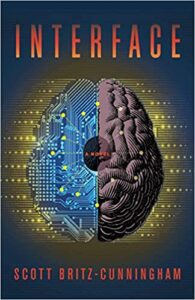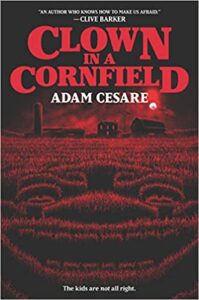Interface by Scott Britz-Cunningham
Keylight Books, Nov 1, 2022
ISBN: 9781684428816
Available: Hardcover, paperback, Kindle edition
( Bookshop.org | Amazon.com )
Interface is a good old-fashioned thriller with a sci-fi bent to it. If your idea of horror is what people have become due to cell phones and information/social media overload,, this is perfect for you. Author Cunningham has put together a rollicking, fun ride in the possible future, with some pretty profound insights about the dumbing down of society thanks to the Internet, mixed in. This is good stuff, and it’ll make you think.
It is the near future, and everyone over the age of 14, by law, is connected to the Interface. Imagine everything your cell phone can do hard-wired into your brain through a tiny implant. You can do anything online through the power of thought. Instant news feeds, file shares, non-verbal communication: all without pressing a button. Trouble strikes when isolated cases of individuals going mad and killing people start., Detective Yara Avril suspects that the Interface implants may be the cause. The rest of the book is a madcap run as Yara, and sleazy yet intrepid reporter Jericho Jones, pursue the truth and try to prevent further deaths, while every power of what’s left of the government opposes them.
There’s really nothing to find fault with in the book. The pacing is fast, and the characters do an excellent job representing their factions, while blurring the lines between good and evil. Egon Graf is the head guy for the government, which needs the Interface to stay in power. Opposed to him is his brother Taiki, who is bent on taking down the Interface, which he created years before. The story does a nice job playing on the axiom “the ends justify the means”, when it comes to how much murder can be justified to prevent the future idiocy of humanity. The author’s vision of the future is scary: it’s a future ruled through human emotion, not logic. Why have politicians debate and vote when the public can just vote online, regardless of whether they understand anything? No need for criminal trials, just throw up a quick infomercial online detailing the case, and let the people decide their fate. It’s a scary thought, and maybe not that different from where we are today..
It’s worth noting that for a thriller, there is some pretty deep thought in the dialogue sections. The insights into social media and being “connected” are well thought out, the kind of material you can ponder on your own long after you finish the book. I wound up bookmarking five or six different pages along the way to go back to and re-read, it’s that well done. People will enjoy this book for the ride, but it’ll linger with them long after the ride’s over.
Bottom line: don’t miss this one. Recommended
Reviewed by Murray Samuelson







Follow Us!